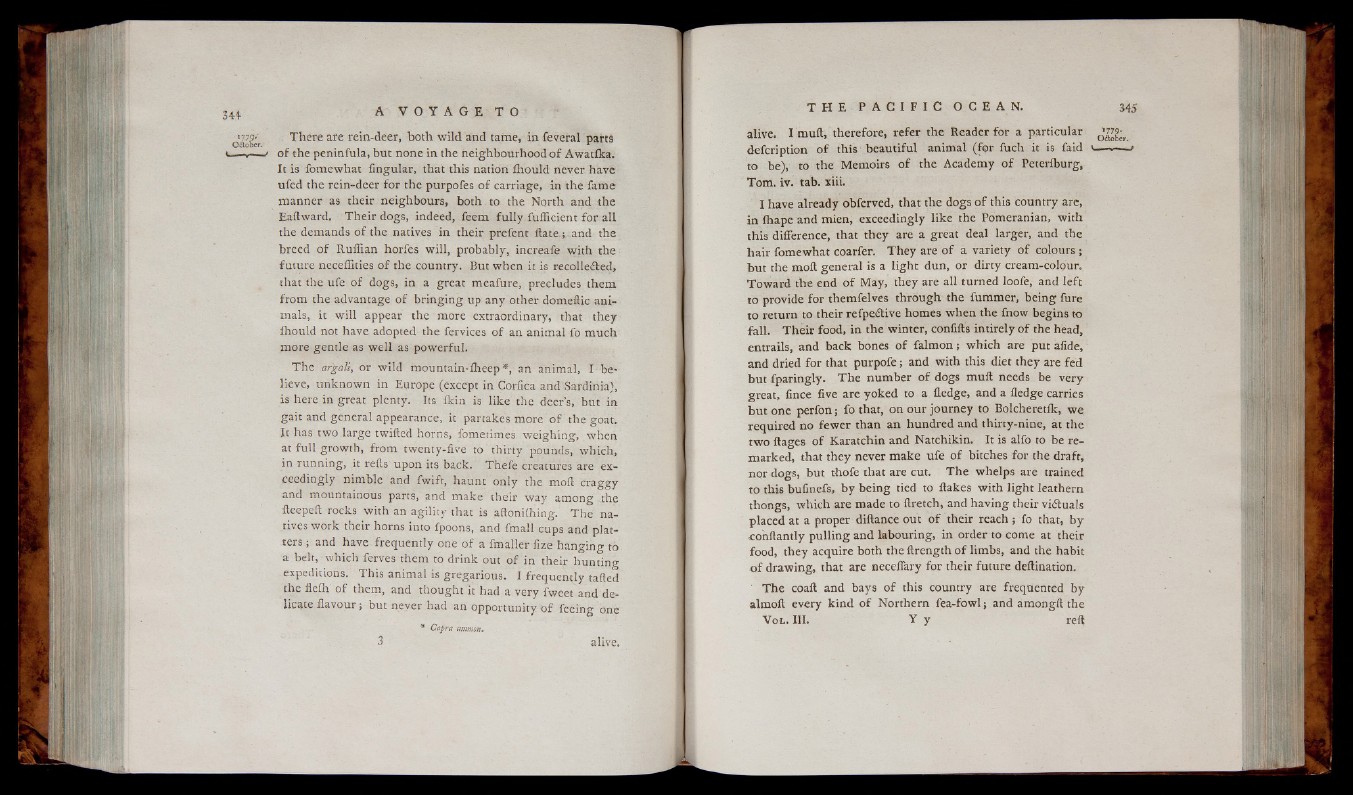
There are rein-deer, both w ild and tame, in feveral parts
o f the peninfula, but none in the neighbourhood o f Awatlka.
It is fomewhat lingular, that this nation fliould never have
ufed the rein-deer for the purpofes o f carriage, in the fame
manner as their neighbours, both to the North and the
Eaftward. T h e ir dogs, indeed, feem fu lly fufficient for all
the demands o f the natives in their prefent fta te ; and the
breed o f Ruffian horfes w ill, probably, increafe with the
future neceffities o f the country. But when it is recollected,
that the ufe o f dogs, in a great meafure, precludes them
from the advantage o f bringing up any other domeflic animals,
it w ill appear the more extraordinary, that they
lliould not have adopted the fervices o f an animal fo much
more gentle as w e ll as powerful.
The argali, or wild mountain-Cheep *, an animal, I believe,
unknown in Europe (except in Corfica and Sardinia),
is here in great plenty. Its Ikin is lik e the deer’s, but in
gait and general appearance, it partakes more o f the goat.
It has two large twilled horns, fometimes weigh ing , when
at fu ll growth, from twenty-five to thirty pounds, which,
in running, it reits upon its back. Thefe creatures are exceedingly
nimble and fwifr, haunt only the moll crag gy
and mountainous parts, and make their way among ..the
fteepeft rocks with an agility that is afloniffiing. T he natives
work their horns into fpoons, and fmall cups and platters
; and have frequently one o f a fmaller fize han ging to
a belt, which ferves them to drink out o f in their hunting
expeditions. This animal is gregarious. I freq u en c y tailed
the fleili o f them, and thought it had a very fweet and delicate
fla v o u r ; but never had an opportunity o f feeing one
I Capra amnion.
3 alive.
alive. I mull, therefore, refer the Reader for a particular ¿¡¡M
defcription o f this beautiful animal (for fuch it is faid > -
to be), to the Memoirs o f the Academy of Peterlburg,
Tom. iv. tab. xiii.
I have already obferved, that the dogs o f this country arc,
in lhape and mien, exceedingly like the Pomeranian, with
this difference, that they are a great deal larger, and the
hair fomewhat coarfer. They are o f a variety o f colours ;
but the moil general is a light dun, or dirty cream-colour.
Toward the end o f May, they are all turned loofe, and left
to provide for themfelves through the fummer, being fure
to return to their refpedlive homes when the fnow begins to
fall. Their food, in the winter, confifls intirely o f the head,
entrails, and back bones o f falmon; which are put afide,
and dried for that purpofe; and with this diet they are fed
but fparingly. The number o f dogs muft needs be very
great, fince five are yoked to a fledge, and a fledge carries
but one perfon; fo that, on our journey to Bolcheretik, we
required no fewer than an hundred and thirty-nine, at the
two ilages of Karatchin and Natchikin. It is alfo to be remarked,
that they never make ufe o f bitches for the draft,
nor dogs, but thofe that are cut. The whelps are trained
to this bufinefs, by being tied to flakes with light leathern
thongs, which are made to ftretch, and having their viilnals
placed at a proper diftance out o f their reach; fo that, by
conftantly pulling and labouring, in order to come at their
food, they acquire both the ftrength o f limbs, and the habit
o f drawing, that are necefiary for their future deftination.
' The coaft and bays o f this country are frequented by
almofl every kind o f Northern fea-fowl; and amongft the
V ol. III. Y y reft